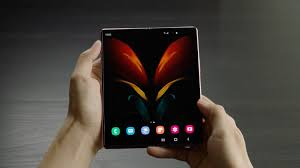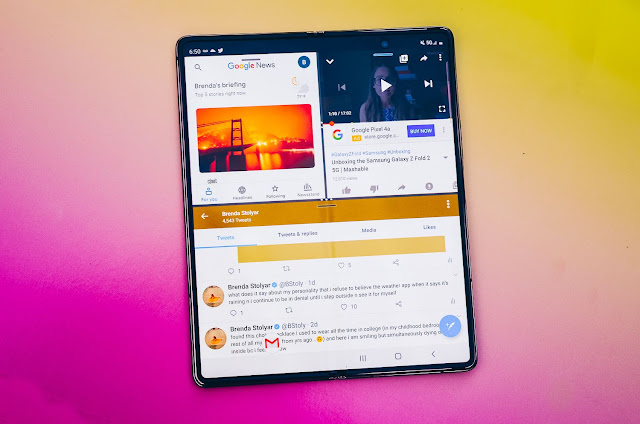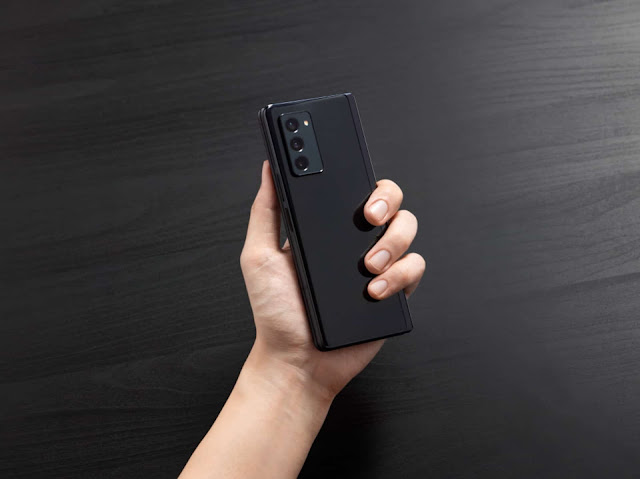
Galaxy Z Fold 2: The new foldable phone king
That device, which costs $1,300 retail, has 5x optical zoom that the Z Fold 2's 2x optical zoom wishes it could be, and a few other fancy features that I could usually take or leave. Zooming into architectural features on a day trip to San Francisco, or seeing animals in nature, was a lot less satisfying on the Z Fold 2 compared to the Ultra. A beautiful view of San Francisco's iconic Ferry Building on a beautiful day, but the Z Fold 2's 2x optical zoom is no match for 5x if we wanted to get a little more close and personal.

Photos are still good -- very good, even better -- but this isn't the most superior camera phone that Samsung makes. There are pro photo and pro video modes, which bring it up to date, and I do like being able to unfold the device to take a higher-quality selfie with the rear cameras.
The Z Fold 2's outer screen serves as a viewfinder if you tap the right onscreen control, but it's awkward to hold the phone this way while taking a photo, and everything looks slightly off-kilter if you're looking at yourself onscreen and not the camera sensor. I also noticed that a lot of my standard photos seemed ever so slightly askew. Reviewing pictures on the 7.6-inch screen, though, is a dream.
I genuinely thought Flex Mode would be the Z Fold 2's killer feature, but it didn't quite work out as expected. Flex Mode is Samsung's way to describe the state of the Z Fold 2 when you bend the two screens in between totally closed and fully open, and the two "sides" stay where they are.
The benefits are plenty real. The phone can prop itself open from a range of at least 75 to 115 degrees, which means it can become its own stand vertically or horizontally, and some apps can shift to take advantage of the new dimensions. That essentially splits the interface so that, for example, you can see a video on "top" and other navigation options on the "bottom."
For example, when the Z Flip bends in half, it forms two squares. The bottom creates a stand and the top has a centered video camera that's intuitive to use for video calls, reading, watching videos and framing photos from front and rear cameras.
Meanwhile, the angles on the Z Fold 2 never felt quite right for most of those. Samsung says there are more apps coming to take advantage of the split-screen design -- I certainly hope that's the case.
Battery life better than I feared
I worried about the Z Fold 2's ability to deliver all-day battery life with its 4,500-mAh battery capacity. Note that these are two separate battery cells that together create the same total capacity as the Note 20 Ultra, a phone I thought had middling battery performance because of its resource-hungry 120Hz screen.
Now, add into the equation two battery cells that are generally thought of as less efficient than one big battery (because of battery chemistry) and a really big 7.6-inch screen that refreshes at twice the rate of a typical screen (using more battery) and you can understand the skepticism.
However, the day I exchanged my laptop for a Z Fold 2, I used resource-hungry live maps navigation for 2 hours in a 28-hour period, browsed and messaged nonstop, watched hours of Netflix, took dozens of photos and so on. Even on this heavy day, I still managed to get from morning to evening on a single charge.
Part of that is because the 7.6-inch internal screen only uses 120Hz screen refresh rate on an "adaptive" cycle, which means it automatically flicks on when you're doing something intensive enough to warrant the ultra smooth scrolling, gaming and more. The rest of the time it reverts to 60Hz (like the outer screen, which I used at least 60% of the time), and which held reserves in check.
Battery life isn't amazing, but it's more than doable, and for a device like this, I consider that a positive. You can also manually switch the inner screen's refresh rate to 60Hz and if you enter battery-saving mode, 120Hz will fall away. You can use the outer screen as a viewfinder for taking selfies from the main camera -- neat trick.
Multitasking: I love Samsung's new multi-window app feature -- mostly -- because it makes it so much easier to split the 7.6-inch screen into two or three zones to use apps at the same time. Dividing the screen this way felt natural and helpful for periods of time.

In this iteration, when you have one app open, you're able to swipe out from the side menu, select an app and drag it into one of three locations: to the right or left pane, horizontally, bottom (a vertical position below the main window), or a pop up in the middle of what you're looking at. This is great flexibility here.
Unfortunately, not every app you have installed works with this layout, including apps sand boxed in the "Work Profile" section of Samsung's Knox security that works with corporate apps. It's a shame, since the productivity apps are among the ones I want to multitask with the most.
Typing: Once again, I have to commend Samsung for making a split screen keyboard for the interior Fold screen. The goal is to make typing more comfortable on a wider-than-usual device that's most beneficial when it's fully unfolded into tablet form.
However… my hands are on the smaller side, which means that even on the split-screen keyboard my paws feel stretched. There really aren't third party apps to replace the default keyboard, which means I wind up collapsing the unfolded phone -- bending it slightly toward the center -- to get the two sides together and gain some typing relief. If your hands are larger, you may not mind as much, but it's not a design for everyone.
Apps that work for the screen: Samsung is slowly but surely working on apps to take advantage of the Z Fold 2's bendable design in any formation. For example, there's drag and drop between Gmail, Chrome, Microsoft Outlook and Samsung native apps. Other apps, like YouTube video, will play nice with the configuration. But until this catches on for all, expect some bootstrapping to get it all how you like.
Here's what happens. You enroll up to four fingerprints when the phone is completely flat, unfurled (not folded in half), but if you try to unlock the device when it's closed, your thumb has to find the precise angle and divot in the bottom portion of the stacked screen sandwich to unlock it without error or delay. Despite this very convenient placement and setup, I had to punch in my backup credentials more times than not.
Should you get the Galaxy Z Fold 2?
A $2,000 phone isn't a paltry affair, especially when 50% of the screens are fragile and finicky at best. But I have a completely different viewpoint than I did of the first Galaxy Fold -- to the benefit of the successor. The Galaxy Fold was a mesmerizing beta phone, a blueprint, meant for the most dedicated of tech advocates living on the edge while Samsung and the rest of the industry worked out the details.
Samsung has expanded its VIP club for foldable phones. Anyone who buys a Z Fold 2, Fold or Z Flip (including the new Z Flip 5G) gets access to the program.
Thus I would suggest, with so many benefits packed together, you should try out your hands on the new Galaxy Z Fold 2 mobile phone.

At the end let me also mention that the photo credit goes to SAMSUNG.







0 Comments